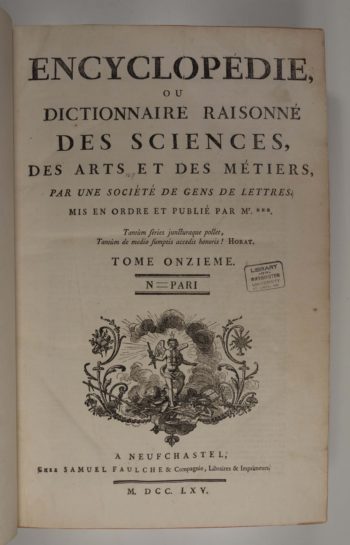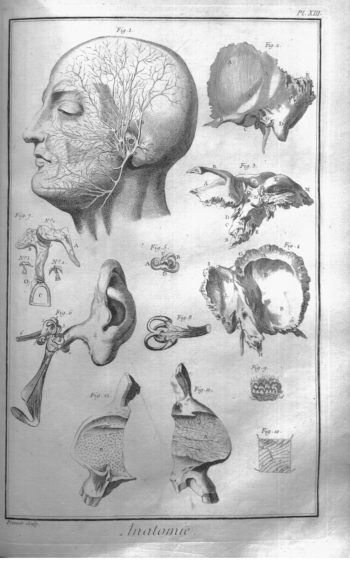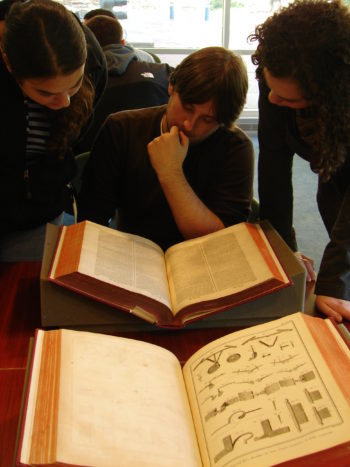
A Revolutionary Encyclopedia
The Encyclopédie, Ou Dictionnaire Raisonné Des Sciences, Des Arts Et Des Métiers, often referred to simply as Encyclopédie or Diderot’s Encyclopedia, is a twenty-eight volume reference book published between 1751 and 1772 by André Le Breton and edited by translator and philosopher Denis Diderot. This encyclopedia, written by a collaborative group of “men of letters,” is commonly viewed as a principle work of the Enlightenment and was highly influential in shaping and spreading the kind of progressive thinking that eventually led to the French Revolution.

Diderot’s humble goal in creating the Encyclopédie to encompass “all the knowledge scattered on the surface of the earth” and to provide a practical reference for tradesmen, whose professions were detailed in both the text and illustrative plates of the encyclopedia (see typesetting plate below). Diderot was well aware of the significance of his project, stating that if it was successful, it should not just be a reference guide but a volume influential in “changing the common mode of thinking” (Diderot “Encyclopedia”).
Honoring the Trades and Deriding the Nobility
One of the main actions of the French Revolution in 1789 was to abolish nobility and hereditary titles, and we can see a hostility toward the nobility emerging in the Encyclopédie. For example, in the entry on “Nobility,” Louis Jaucourt writes, “Democracies have no need for nobility, they are even more peaceful when there are no noble families” and “Noble birth commonly stifles industry and emulation. Nobles do not have so far to go as do others in order to reach the highest levels.” Even in the illustrations to the Encyclopédie, the affluent, when they are depicted at all, are generally pictured as pompous and lazy.

While the encyclopedia denigrates the nobility, it elevates the average working man. The illustrations in his encyclopedia focus primarily workers, depicting them as noble and industrious. Diderot himself was the son of a respected cutlery maker and viewed the trades as just as important as the arts and a special source of pride for France. His encyclopedia is the first to include detailed descriptions of various trades.
Struggling with Church Censorship
The full title of the Encyclopédie, which refers to it as a Dictionnaire Raisonné or “Rational dictionary,” highlights its emphasis on reason, which frequently put it at odds with the conservative church. The project was subjected to Jesuit censorship multiple times during its publication for its liberal and controversial material. The publisher Le Brenton removed some controversial content without Diderot’s consent or knowledge, but much of it remains in the completed volumes, though it is often masked or hidden in obscure articles.
It is clear that these precautions to hide liberal religious views were necessary, because in 1749 Diderot was arrested for publishing an essay titled Lettre sur les aveugles (An Essay on Blindness) that suggested an evolutionary theory of survival. He spent three months in prison before he was allowed to return to work on the encyclopedia, undaunted by further threats from the church. Special Collections has an original copy of this heretical essay in the Philip Mills Arnold Semiology Collection.
Contributors

A project with as monumental a goal as encompassing all of human knowledge necessitated a multitude of knowledgeable contributors in many different fields. Diderot’s encyclopedia was one of the first to have multiple named contributors, the most famous of whom were Jean-Jacques Rousseau and Voltaire who contributed articles on music, political theory, literature, history, and philosophy. Diderot himself wrote many of the articles, and oversaw the preparation of the 3,000-4,000 plates that illustrated many of the textual entries, including many on industrial professions.
Where to Find More
If you would like to see the Encyclopédie for yourself, the Julian Edison Department of Special Collections has all 17 volumes of text, the 11 volumes of illustrative plates, and the two-volume index, and five supplemental volumes published under other editors.
Reproductions of all of the illustrations in the encyclopedia are also available in the Arts and Architecture library.